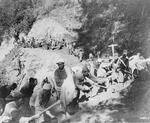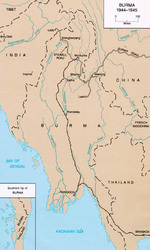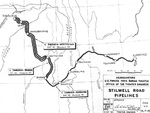Burma Road and the Hump
Contributor: David Stubblebine
ww2dbaseThe Burma Road and the Hump actually describes three different truck-convoy ground transportation systems and one airborne transportation route. They all served the same purpose, however: to deliver large quantities of British and American supplies into western China in support of the Nationalist Chinese.
ww2dbaseThe Burma Road
ww2dbaseThe first line of supply used for this purpose was the Burma Road, a truck route from Lashio, Burma (now Myanmar) to Kunming, China. Supplies arrived by ship in Rangoon (now Yangon) in Burma and traveled by rail through Mandalay to Lashio. The trip from Lashio into China was too mountainous for a reliable railroad to be built in time to do China any good so a road was cut over the mountains instead. Burmese and Chinese laborers built the road with little heavy machinery under extremely primitive and deplorable conditions. Construction took place in 1937 and trucks started moving cargo into China in 1938. The road was closed down for two months in 1940 for diplomatic reasons but otherwise ran fairly continuously until the Burmese end was overrun by the Japanese in 1942. Cutting this line of supply was one of the primary reasons Japan decided to enter Burma.
ww2dbaseThe Kunming-Chungking Road
ww2dbaseThe overall purpose of the supply effort was to deliver goods to Chungking (now Chongqing), China's wartime capital. Chungking was where the supplies were redistributed to final destinations throughout China. The Burma Road was built into Kunming where it linked with another road that led to Chungking. This leg was still in the Himalayan foothills so it also had very mountainous sections. The famous series of tight switchback turns known as "24-turns" was on the Kunming-Chungking Road and not the Burma Road as is often thought. The Kunming-Chungking Road remained operational throughout the war, even as the changing fortunes of war forced the other legs to adjust how supplies were being delivered to Kunming.
ww2dbaseThe Hump
ww2dbaseThe loss of the Burma Road in 1942 necessitated a hasty arrangement to fly the supplies from airfields in the Assam Province of India to Kunming, China. From there, the supplies were still trucked to Chungking. This air route went over the eastern part of the Himalayan Mountains and so the route became known to the pilots as "The Hump." The airlift began as hastily thrown together arrangements but settled down into a very efficient and expansive air-freight operation. The Hump flights started with the venerable Douglas C-47 Skytrain but quickly shifted to give the Curtiss C-46 Commando its greatest glory days. The Commando could carry over twice the payload as the C-47, it could handle high altitudes better when fully loaded, and the double cargo doors worked out better for loading and unloading. By the end of the war, the primary airlift aircraft had shifted to the Douglas C-54 Skymaster. Even with the opening of an alternate ground route in early 1945, The Hump remained the principal supply route until after the war ended.
ww2dbaseThe Ledo Road
ww2dbaseWith the recapture of Myitkyina in northern Burma in 1944, a road from Ledo in Assam, India was opened through Myitkyina and reconnected with the old Burma Road at Mong Yu, Burma at the Chinese border. This reopened access to Kunming by truck in early 1945 and the recapture of Myitkyina also shortened and flattened The Hump air route. In terms of sheer tonnage moved, the new Ledo Road carried only about 10 percent of what was being flown over the Hump so the airlift remained China's primary supply option through to the end of the war and briefly beyond. Even though it carried less tonnage, the value of the Ledo Road was that it was the route used to lay a fuel pipeline from Assam to Kunming. Fuel pumped through this pipeline was fuel that did not have to be trucked or flown to China and was a very valuable addition to the system.
ww2dbaseThe Stilwell Road Name Change
ww2dbase"The Ledo Road" was the name of the road from Ledo to the intersection with the old Burma Road. Shortly after the Ledo Road opened, the road from Ledo through to Kunming, including the section of the former Burma Road, was formally renamed the Stilwell Road after United States Army General Joseph Stilwell, the Allied area commander. Portions of the road still bear that name today.
ww2dbaseSources:
Wikipedia
The Ledo Road by Carl Weidenburner
Last Major Update: Jul 2015
Burma Road and the Hump Interactive Map
Photographs
 |  |  |  |
Maps
 |  |  |  |
Burma Road and the Hump Timeline
| 24 Jun 1940 | Japan requested Britain to close the Burma Road, a land supply route into China. |
| 17 Jul 1940 | The United Kingdom announced that the Burma Road would be closed as it diverted resources to deal with the war at home. |
| 18 Oct 1940 | Britain reopened the Burma Road, the over-land supply route to China. |
| 2 Nov 1941 | Hugh Woods and William L. Boyd of the China National Air Corporation (CNAC) made the first flight over the Hump, the China-Burma air supply route. |
| 27 Sep 1942 | Joseph Stilwell received orders to plan for an offensive into northern Burma to open the Ledo Road and Burma Road. |
| 2 Dec 1942 | US Air Transport Command began flying "the Hump" into China. |
| 2 May 1943 | Franklin Roosevelt informed George Marshall that he was going to approve the supplies Chiang Kaishek requested without any caveats, which included 500 planes and 10,000 tons of supplies to be delivered over the Hump. |
| 19 Oct 1943 | Louis Mountbatten met with Chiang Kaishek for the second day in a row. Mountbatten offered Chiang 10,000 tons of supplies to be flown over the Hump to China each month, while Chiang allowed Mountbatten to launch guerrilla operations into northern Burma. |
| 27 Nov 1943 | Chiang Kaishek asked Joseph Stilwell to secure 10,000 tons of supplies to be flown over the Hump into China per month, while China would not make commitment on any American demands. |
| 27 Dec 1943 | As of this date, the Ledo Road was 103 miles long from Ledo, India into the Patka Mountains in northern Burma. |
Please consider supporting us on Patreon. Even $1 per month will go a long way! Thank you. Please help us spread the word: Stay updated with WW2DB: |
Visitor Submitted Comments
14 Feb 2019 06:57:53 AM
My uncle which i am named after, Michael Strus who was a B-24 B-25 and B-29 bombardier. He never talked much about the war But he told me he had flow over the hump several times. And had to bail out of the bomber on the way back from a mission over the water because they ran out of fuel. I have some of his military patches and i believe one for each trip over the hump. I have them packed away ill have to look for them.Do you have any information on my uncle or do you know where i can get some on my uncle. Thank You Mike W. Strus
23 Mar 2020 09:36:53 AM
I am trying to gather information about my uncle Hilton Axford who was a pilot flowing the Hump
Thanks
7 Apr 2020 05:30:03 PM
My dad was c-46 Hump pilot, flew to a destination on Individual Flight Record noted as Chak, also left from A-1, A-3, and A-7. Where are they? I finally figured out that Chara was Kalachara. I also want to understand what the column, under 400 hp indicates.
20 May 2020 05:11:08 AM
My father, Richard Pocock, flew the Hump in WWII - outlying C-54s, I believe. I have not been able to locate is full military records but will continue to search for them.
25 May 2020 11:57:39 AM
I am looking for information about my Uncle, Howard Vorbeck who died flying the hump in World War 2. I think he died in June 1944.
3 Feb 2021 12:59:20 PM
My father, Robert E. Lee Corbin, was a medical corpsman on some of the aircraft that flew "The Hump". He passed in 1950 when I was only 3 mo. old. Would love anyone with knowledge of him to reply.
12 Jun 2021 09:33:13 AM
Trying to find more info about death of Langdon Dwight Long who died in December 1942 flying the hump. Bodies of crew never found.
13 Nov 2021 09:44:10 AM
My earlier entry about Lt. Langdon Dwight Long contained an error. He & his fellow crew members were reported missing in action on June 3, 1942. They were thereafter declared to have died on that date, and their remains were never recovered. Lt. Long was my uncle and I would appreciate any information from individuals who may have known him or who had relatives that trained or flew missions with him.
8 Jun 2022 03:55:30 PM
I worked for N. Dellere in Manhatten,Kansas from 1959 until 1963. Nick flew the hump in C46’s.
God Rest His Soul.
All visitor submitted comments are opinions of those making the submissions and do not reflect views of WW2DB.
» Chin, Arthur
» Wei, Lihuang
Locations:
» Burma
» China
» India
- » 1,169 biographies
- » 337 events
- » 44,828 timeline entries
- » 1,244 ships
- » 350 aircraft models
- » 207 vehicle models
- » 376 weapon models
- » 123 historical documents
- » 261 facilities
- » 470 book reviews
- » 28,520 photos
- » 365 maps
Fleet Admiral Chester W. Nimitz, 16 Mar 1945
Please consider supporting us on Patreon. Even $1 a month will go a long way. Thank you!
Or, please support us by purchasing some WW2DB merchandise at TeeSpring, Thank you!
28 Feb 2017 06:19:01 PM
I believe the gentlemans name wasWilliam L. Bond, not Boyd. i hope this was helpful, my father in law, William McDonald jr was with CNAC and was a close friend of Mr. Bond.